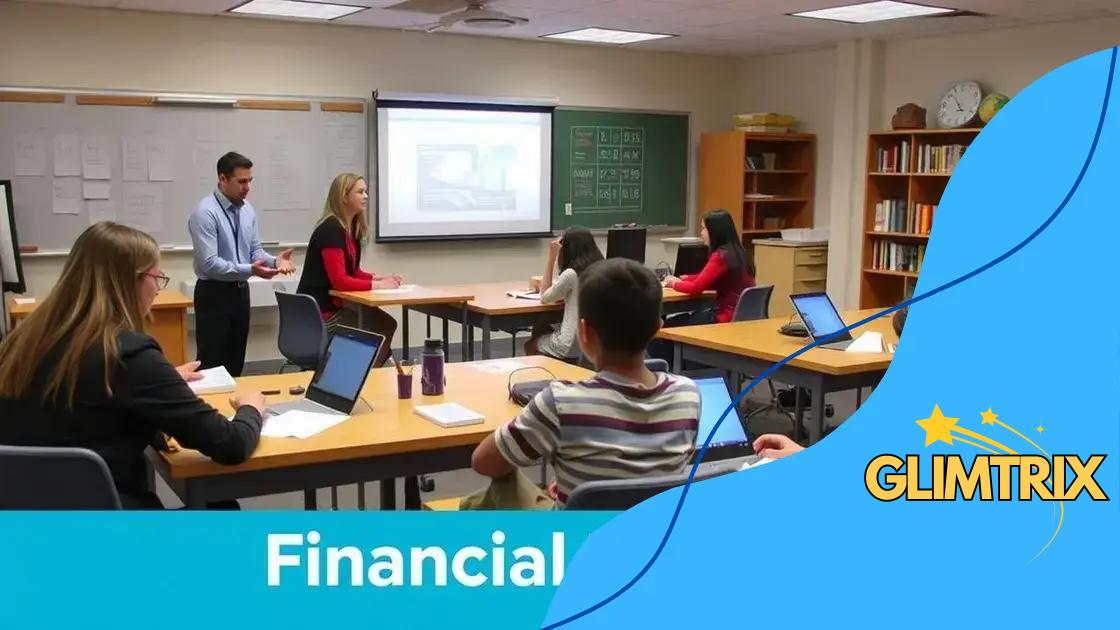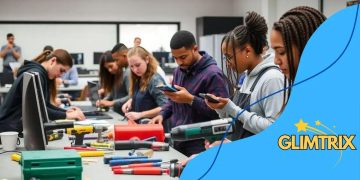Financial literacy integration in high schools: a necessary step

Integrating financial literacy into high schools equips students with essential money management skills, preparing them for financial responsibilities and promoting long-term economic well-being.
Integrating financial literacy in high schools is crucial for preparing students for real-world financial challenges. Can you imagine graduating without knowing how to manage your finances? In this article, we’ll explore the significance of this integration and how it impacts students’ lives.
Understanding the importance of financial literacy
Understanding the importance of financial literacy sets the foundation for young people’s financial futures. When students grasp basic financial concepts, they can navigate life’s financial challenges more effectively. This knowledge isn’t just beneficial; it’s essential for making informed decisions.
Impact on Daily Life
Financial literacy helps students understand how to manage their money wisely. They learn budgeting, saving, and investing skills that empower them to make sound financial choices.
- Budgeting skills allow for better control over spending.
- Saving encourages emergency preparedness and future planning.
- Knowing about credit helps in making responsible decisions regarding loans.
Additionally, understanding financial literacy cultivates a sense of responsibility. It can drastically reduce economic disparities, foster independence, and encourage smarter decisions in various aspects of life.
Long-Term Benefits
The effects of financial literacy extend beyond school. Young adults who understand financial concepts are likely to experience greater financial stability. They are more prepared to handle debts, navigate investments, and even plan for retirement strategically.
Moreover, financially literate individuals can invest in opportunities that arise, enhancing their overall quality of life. By encouraging even basic financial education in high school, we help foster a generation that is informed and capable of creating a secure financial future.
Key components of a financial literacy curriculum
Key components of a financial literacy curriculum help shape students into informed financial decision-makers. Understanding what to include is crucial for effective learning. Each component serves a specific purpose that equips students for future challenges.
Essential Topics
A solid financial literacy curriculum should cover essential topics. This creates a comprehensive framework that prepares students. Important areas to focus on include:
- Budgeting: Teaching how to create and maintain a budget is fundamental. It helps students track their income and expenses effectively.
- Saving: Understanding the importance of saving money can foster good habits that benefit students in the long run.
- Credit management: Concepts of credit, including credit scores and responsible borrowing, are crucial for financial health.
- Investing: Introducing the basics of investing can pave the way for students to grow their wealth over time.
Including these topics sets the foundation for better financial habits. It’s important for students to not only learn but also apply these principles practically.
Interactive Learning Methods
Incorporating interactive methods into the curriculum enhances engagement. Students often learn better through hands-on experiences. Role-playing activities or simulations that mimic real-life financial situations can be very effective.
Group projects help students collaborate and learn from each other. These methods make the learning process enjoyable while reinforcing key concepts.
Furthermore, teaching technology usage—like personal finance apps—can prepare students for modern financial tools. By familiarizing them with these resources, we encourage proactive financial management.
How to implement financial literacy programs

Implementing financial literacy programs in schools can greatly enhance students’ understanding of money management. This process involves several key steps that ensure effective teaching and engagement.
Assessing Needs
The first step is to assess the needs of the students and the community. Schools should gather information on what financial topics students are most interested in learning. Surveys and focus groups can help highlight gaps in knowledge.
Engaging teachers and parents in this process is crucial. Their insights can provide valuable information on what financial challenges students may face.
Creating a Curriculum
Once needs are assessed, the next step is creating a curriculum that is both relevant and comprehensive. The curriculum should include fundamental topics such as budgeting, saving, and investing. It’s important for the material to be age-appropriate and relatable to students’ lives.
- Incorporate real-life scenarios: Using practical examples can help students connect the lessons to their daily experiences.
- Include interactive elements: Engaging activities, such as simulations and group projects, can enhance learning.
- Utilize technology: Integrating apps or online resources into lessons can keep students interested.
Involving local community organizations can also provide additional resources or guest speakers to enhance the curriculum. This enriches the students’ learning experience and exposes them to various perspectives.
Training Educators
Training teachers is essential to the success of any financial literacy program. Schools should provide educators with the necessary tools, training, and resources. Workshops and professional development sessions can equip teachers with the knowledge to teach financial concepts effectively.
Ongoing support for teachers is critical. Regular check-ins and opportunities for collaboration can help maintain enthusiasm and effectiveness in teaching.
Additionally, gathering feedback from students and teachers after the program starts can help identify areas for improvement. This process allows for adjustments to be made, ensuring that the program develops according to the needs of the students.
Successful case studies of financial literacy in schools
Successful case studies of financial literacy in schools illustrate the effectiveness of teaching students about money management. These examples showcase how schools can successfully implement programs and the positive impact they have on students.
Case Study 1: High School A
High School A introduced a financial literacy program that emphasized real-world applications. They taught students how to create budgets and manage expenses. The program included interactive workshops where students participated in simulations of real-life financial situations.
- Increased Engagement: Students showed higher interest in their finances through hands-on activities.
- Improved Knowledge: Pre- and post-tests revealed significant gains in financial knowledge among students.
- Community Participation: Local banks provided resources and guest speakers, enhancing the program’s reach.
This program prepared students for real-world financial responsibilities, contributing to better financial decision-making.
Case Study 2: Middle School B
Middle School B adopted a unique approach by integrating financial literacy into existing subjects like math and social studies. This interdisciplinary method made lessons relevant and relatable for students.
Teachers reported that using real-life examples helped students grasp complex concepts better. Students participated in projects where they researched different types of investments and savings plans.
Additionally, students practiced creating financial plans for hypothetical scenarios. This approach boosted their understanding significantly and led to a rise in students’ interest in pursuing financial topics further.
Case Study 3: Elementary School C
Elementary School C focused on teaching younger students the basics of financial literacy through story-based learning and games. They introduced concepts like saving and spending using age-appropriate materials.
Simple, engaging activities helped instill foundational financial habits. For example, activities included saving challenges and classroom stores where students could use play money.
Teachers noted that these fun, interactive methods made financial concepts easier to understand, leading to positive attitudes towards money management from a young age.
These case studies demonstrate that with the right strategies, schools can successfully teach financial literacy. They show the importance of practical applications, community involvement, and creativity in education.
Challenges in teaching financial literacy and solutions
Teaching financial literacy presents unique challenges that educators must navigate. Understanding these challenges helps in developing effective solutions that can lead to successful educational outcomes.
Challenge 1: Lack of Resources
Many schools struggle with limited resources for teaching financial literacy. This may include a lack of textbooks, practical learning materials, or trained educators. Without proper resources, it can be difficult to implement a comprehensive curriculum.
To address this, schools can seek partnerships with local banks and financial institutions. These partnerships often provide materials and guest speakers to enhance the curriculum. Additionally, leveraging online resources can help fill in gaps at little to no cost.
Challenge 2: Teacher Training
Another challenge is ensuring that teachers are well-equipped to teach financial topics. Many educators may not feel confident in their financial knowledge, which can lead to less effective teaching methods.
Providing professional development workshops focused on financial education can empower teachers. These workshops can enhance their confidence and skills in delivering relevant content. Teachers should also have access to ongoing support and resources to keep their financial knowledge updated.
Challenge 3: Student Engagement
Engaging students in financial literacy can be difficult, especially when they perceive the material as boring or irrelevant. To overcome this barrier, instructors should incorporate interactive and relatable lessons.
- Use real-life scenarios: Students often resonate more with lessons that reflect their everyday experiences.
- Incorporate technology: Using apps or online tools for budgeting and saving can make learning fun.
- Implement games: Educational games can capture students’ interest and make learning about finances enjoyable.
By making lessons more engaging, students are more likely to participate actively and absorb the material.
Challenge 4: Curriculum Integration
Integrating financial literacy into existing curriculums can be challenging as well. Many educators find it difficult to fit financial topics into already packed schedules.
One solution is to coordinate with other subjects to find common ground. For instance, linking math lessons to budgeting can reinforce both subjects. Team teaching between educators of different subjects can also help in creating a more cohesive learning experience for students.
Understanding these challenges and their solutions can enhance the teaching of financial literacy in schools. By addressing these barriers head-on, educators can create a supportive learning environment that promotes financial responsibility.
FAQ – Frequently Asked Questions about Financial Literacy in High Schools
Why is financial literacy important for high school students?
Financial literacy equips students with essential skills to manage money, make informed decisions, and prepare for their financial futures.
What are common challenges in teaching financial literacy?
Challenges include a lack of resources, insufficient training for educators, and difficulties engaging students in the subject matter.
How can schools effectively implement financial literacy programs?
Schools can implement financial literacy by assessing student needs, using interactive methods, and training teachers to deliver the content confidently.
What are the benefits of financial literacy education?
The benefits include improved money management skills, increased financial responsibility, and the potential for better economic outcomes in students’ futures.





